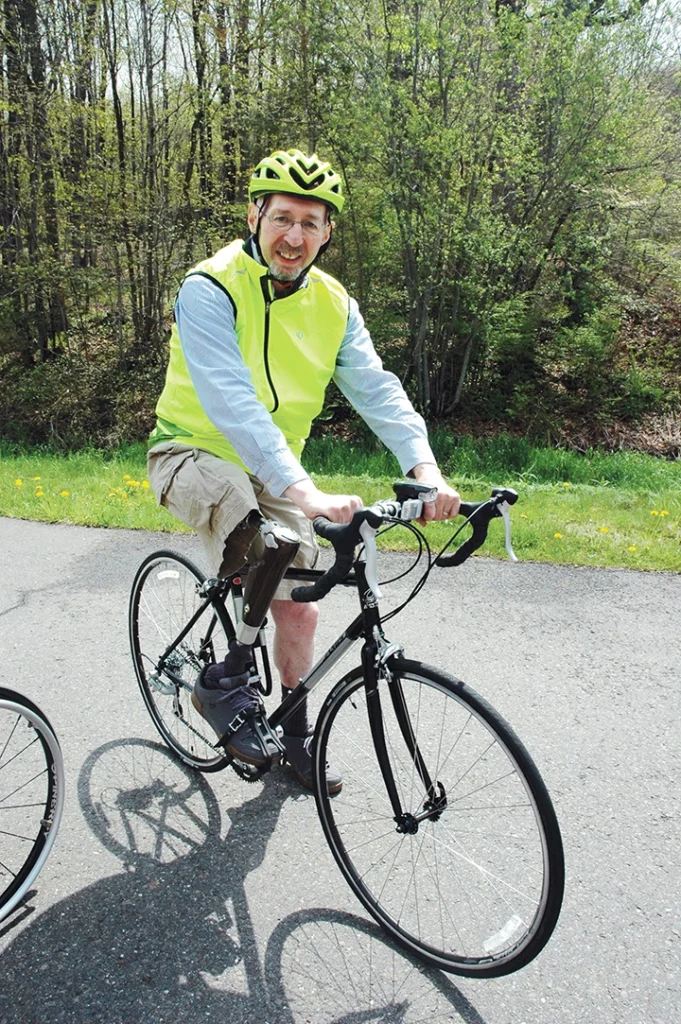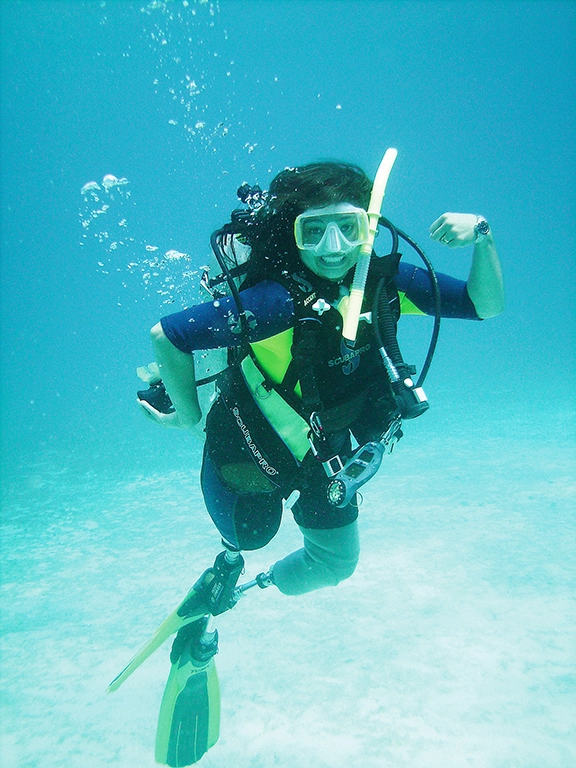By Élan Young
Losing one or both legs, regardless of amputation level, will certainly disrupt your life and set you on a different trajectory than what you had planned. For a while, all the other things that seemed important will fall away as your main focus becomes healing and pain control. Then, when appropriate, you may move on to physical therapy and occupational therapy to start learning to navigate the world again.
Whether you choose to use a prosthesis, crutches, a scooter, a wheelchair, and/or another mobility device to get around, you’ll need to ensure that you are able to do so efficiently and safely.
The transition to navigating in a world that is largely set up to accommodate people with two legs may be more or less difficult depending on how much peer support you have, your physical health, and your mental outlook. No matter the circumstances, however, there are some strategies, techniques, and tools that will help you participate in the world in ways that mitigate the challenges of living with limb loss.
Adopting a Good Attitude

Image courtesy of Herb Kolodny.
Wisdom shared by Herb Kolodny, who is an above-knee amputee, is that a good attitude begins with understanding that walking will probably be possible again. His journey led him to believe that whether a person does or doesn’t walk again is largely a matter of choice. Interestingly, he learned this before he became an amputee.
Before the surgery to amputate his right leg above the knee due to a recurrence of cancer at age 65, he attended a support group for amputees to see what he would be facing. When he got there, he looked around and wondered when all the amputees would show up. As it happened, they were amputees, but he couldn’t tell because they were all wearing long pants that day. “They all strolled in without the use of crutches or a cane, so I knew immediately that if they could walk again, so could I,” he recalls of that pivotal moment.
This experience helped shape Kolodny’s attitude toward limb loss, which he and many professionals agree is critical to a successful recovery. “The longer an individual stays depressed and feeling sorry for themselves, the longer will be their journey toward attaining their new normal,” he says. “I turned the process into an exciting new adventure.”
Kolodny’s attitude helped him gain confidence to stand with a prosthesis one day after surgery and walk with the help of a walker three days later. After one month, he was walking with two crutches, and after two months, he only used a cane. While not everyone will progress as quickly as he did, there is evidence to suggest that a positive outlook helps people recover faster. Three years later, Kolodny still uses a cane outside his home, but his gait is vastly improved because he persistently works on it.
Kolodny insists that no one should confuse a positive attitude for a “go-it-alone” approach. While it’s nice to do things independently, he says there is a balance between asserting independence and accepting help from others. “Do as many things independently as you possibly can, but then be prepared to accept help when you are unsure of your capabilities or when you are too tired,” he says. “There is no shame in asking for help when you need it.”
Katrin Green, a gold- and bronze-medal Paralympian and below-knee amputee since age 5, echoes that there are many resources to help new amputees, and no one should try it alone. “It’s okay to grieve for your limb. It’s okay to seek counseling. It’s okay to ask for help,” she says. “You will be a role model and inspiration to others throughout this journey, whether you realize it or not.”
Planning Ahead

Image by Scott Sabolich Prosthetics & Research.
Maria Greenfield, director of the occupational therapy department at J.D. McCarty Center for Children with Developmental Disabilities, who is herself a lower-limb amputee, says the first consideration will be your ability to move in bed and whether help is needed to do so. She offers the following questions to help make an assessment for everything else: “Once that hurdle is overcome, it is time to ponder the goal of the day. Will I need a wheelchair, a cane, crutches, or a prosthesis? Do I need specialty prostheses (waterproof or sports)? Are my doorways wide enough? Do I have to navigate stairs? How far do I have to travel?”
Greenfield recommends pre-planning tasks or events and thinking through energy conservation strategies to make the day easier to get through. “Exert energy on tasks you enjoy or that must be accomplished, not on walking back and forth multiple times because you forgot something or simply could not carry it,” she says. She adds that if something doesn’t have wheels, she won’t buy it. Aside from the familiar rolling luggage carriers, she has carts for indoors and outdoors, and a wheelchair available any time she needs it. She also finds that reachers and slip-resistant step stools can come in very handy, and a heavy-duty, extra-long shoehorn is a must-have so that shoes fit tightly for maximum stability. Planning ahead can increase an amputee’s comfort and security, which includes ensuring that a bathroom can be accessed anywhere.
“In the U.S., this is usually a minimal burden, and travel is becoming increasingly accommodating,” says Greenfield. “However, call ahead if you are concerned about accessibility and be ready to explain your specific needs as not everyone understands ‘accessible’ or
‘handicapped.’”
Of course, the Internet is a great resource for planning ahead because it can help people put themselves in situations before actually going into them. Whether through pictures on Google Earth or pictures of a building on a website, the Internet can help people learn enough to formulate questions so they can call for further details.
Tools for Success

Image courtesy of Maria Greenfield.
Often we think of tools as material objects, but occupational therapist and upper-limb consultant Debra Latour, MEd, OTR/L, says that in her practice she’s found communication to be one of the most important tools to help a new amputee adapt to the world. “Even if a situation catches you off guard, being willing and able to speak about something that feels uncomfortable—to those we trust and to strangers—will help a person learn how to advocate for themselves,” she says. While there are many teachable moments, not everyone feels comfortable speaking up, but an advocate like an occupational therapist can help prepare a person for the times when they must. “Be prepared to speak with integrity, speak calmly, and educate people,” she says.
Latour is quick to add that communication is not just verbal, but also includes body language and eye contact. “To be able to maintain eye contact is one of the most important things, but it can be a bigger challenge for those who are in wheelchairs,” she says. As a clinician, helping new amputees maintain eye contact with others is a priority. “I like to have that be a part of the therapy from the beginning because it’s hard to backtrack to gain it, especially for someone with a newly acquired loss whose body image, sense of movement, and sense of self is in havoc,” she says.
Part of being able to advocate for yourself with clear communication includes becoming informed about your rights. Learning about the Americans with Disabilities Act can help you build confidence.
Latour also recommends a private meeting with the human resources director or a supervisor at work to see how the work environment might be modified.
Green, who wears a prosthesis, recommends talking to an employer about days when the prosthesis can’t be worn or causes discomfort. “It pays to be up front, especially for those who have a physical job, as well as to discuss options for sick time, alternate tasks, flextime, and other arrangements,” she says.
For social situations, getting peer support from another amputee who can walk you through various scenarios can be extremely helpful. Latour cites an example of a young bilateral lower-limb amputee whose rehabilitation process included going to a department store with her friends to negotiate the dressing room, which was not only a fun social activity for her, but also allowed her to try on clothes without the hassle of having to order clothes and then mail them back if they didn’t fit.
Latour also encourages role playing in a safe environment. “Think of some of the most bizarre situations because at some point they might be your reality,” she notes. “When we have the opportunity to practice them, then we won’t be so caught off guard and we can act with dignity and ask for what we need.”
Tips for Smooth Travel
Many amputees enjoy traveling around the country and internationally, but getting about with ease requires some additional forethought. Here are some basic tips:
- Alert the airline and ask for wheelchair assistance at the departure and destination airports if needed. Depending on your situation, you may need help boarding the plane, too. Don’t be afraid to ask for a seat on the airplane that is close to toilets and exits.
- Call hotels and ask for accessible rooms and a bench to use in the shower/tub. Not all hotels have these benches, so you might need to pack your own.
- Alert your friends, family members, or others at your destination(s) about your needs. This should help everyone avoid unpleasant surprises upon your arrival.



